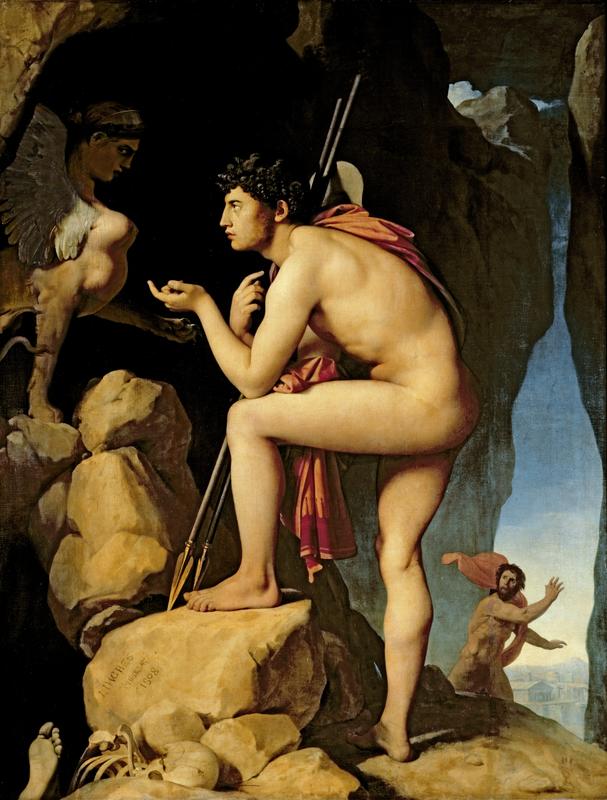More about Oedipus and the Sphinx

Contributor
Ingres paints Oedipus naked as the day he left his mama's womb
“You see this bit here?” Oedipus seems to be saying, his finger extended to indicate which Sphinx-part he means, “This bit is normally on a lady. But what seems to be going on here is that it's attached to bird- and cat-parts. Now, usually when we see those things it's only attached to other bird-, cat- and lady-parts, but the fact that our girl here seems to have all three of them mixed together...well, that right there is the Enigma of the Sphinx.” In the distance our hero's sole remaining listener, having heard Oeddie trot this speech out at one too many parties, prepares to backhand him one across the tuchus.
Or at least that's what the title of this 1808 painting by Jean-Auguste-Dominique Ingres—Oedipus Explaining the Enigma of the Sphinx—might seem to suggest. We're actually looking at a scene from the Greek myth of Oedipus, in which the hero frees the kingdom of Thebes from the monstrous Sphinx by successfully answering her riddle, thereby winning the fair Queen Jocasta's hand in marriage. (Later events would reveal that, unbeknownst to the happy couple, Jocasta was in fact Oedipus's mother. While it naturally ruined both their lives, the knowledge did help to clear a few things up, such as why on their wedding night Oedipus kept telling his new bride “You know, I can't shake the feeling that I've been here before...”) Ingres wisely chose the happier part of this story as his subject.
Jean-Auguste-Dominique Ingres, known to his friends as “Ugh, Will You Just Pick One Already,” won the prestigious Prix de Rome in 1801. This scholarship, awarded by the French government and thus naturally named for a city in Italy, granted promising young artists an all-expenses-paid trip to the Pope's backyard, where they would be expected to paint or sculpt their little hearts out for several years (and to periodically send pieces back home to prove they weren't wasting precious tax-francs). Oedipus, along with another piece called The Valpinçon Painter, was Ingres's official sendin'-home piece of 1808, because he wanted everybody at home to see what a good naked-people-drawer his Eurotrip had made of him. However, he never quite managed to get the piece all the way out of his head, and many years later he decided to return to his old passion project, adding such details as the Sphinx's savin'-for-later dead-guy-foot in the foreground.
Near the end of his life Ingres painted a second interpretation of Oedipus and the Sphinx, attempting to improve upon his youthful impulses by painting the principle parties so that they were facing the opposite direction. This painting, 1864's aptly-named Oedipus and the Sphinx, is decidedly less well-known than the original, possibly owing to Ingres's decision to portray Oedipus with weird frat-boy sideburns but more likely because you can pretty much save yourself a trip by holding the original in front of a mirror. But cut the man some slack—in a world where Charlie Daniels felt the need to record “The Devil Comes Back to Georgia” we ought to be able to look the other way when a Neoclassical luminary retreads the ground he covered in his youth. And if we find that we can't look the other way, that's okay too—thanks toIngres, we can let Oedipus and the Sphinx do it for us.
Featured Content
Here is what Wikipedia says about Oedipus and the Sphinx (Ingres)

Oedipus and the Sphinx is a painting by the French Neoclassical artist Jean-Auguste-Dominique Ingres. Originally a student work painted in 1808, it was enlarged and completed in 1827. The painting depicts Oedipus explaining the riddle of the Sphinx. An oil painting on canvas, it measures 189 x 144 cm, and is in the Louvre, which acquired it in 1878.
Check out the full Wikipedia article about Oedipus and the Sphinx (Ingres)













